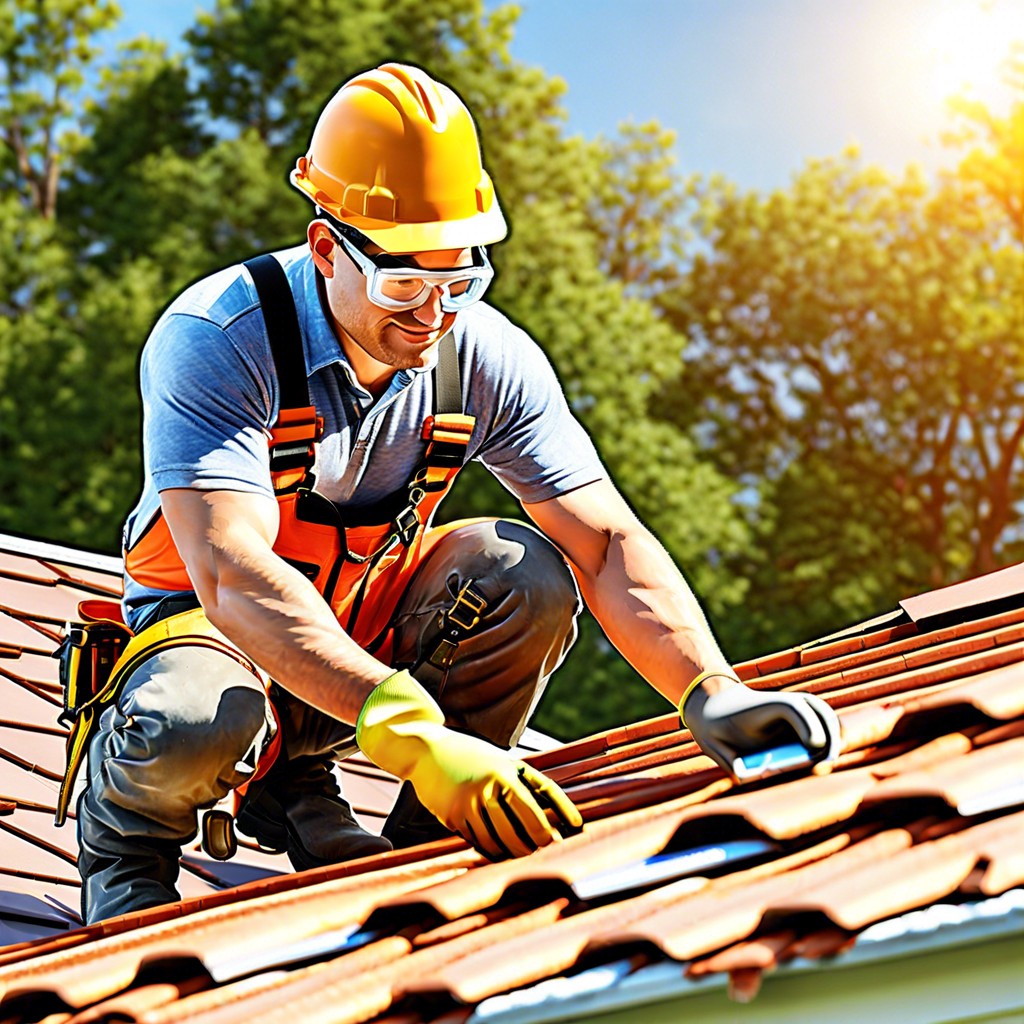Last updated on
Learn the steps to effectively replace roof tiles and keep your home protected from the elements.
Key takeaways:
- Safety precautions: Wear protective gear and work with a spotter.
- Gather necessary tools and materials to replace the tiles.
- Identify and remove damaged tiles with care.
- Install new tiles, ensuring proper alignment and fit.
- Seal and waterproof the new tiles to prevent water damage.
Safety Precautions

Before starting any work on a roof, appropriate safety measures must be put in place to prevent accidents. Wear a helmet, slip-resistant shoes, and gloves to protect against falls and cuts. It’s essential to use a secure ladder that extends at least three feet above the roof edge, and, if possible, employ a harness system for added security.
Working on a roof comes with the risk of falling, so never attempt this job alone. Having a spotter or someone to assist not only increases safety but also makes the task more efficient. Stay aware of the roof’s pitch; steeper slopes require special equipment and techniques. Lastly, ensure that the roof is dry as wet surfaces can be slippery, increasing the risk of falls. If weather conditions are unfavorable, postpone the roof work to ensure safety.
Necessary Tools and Materials
Before commencing the task of replacing roof tiles, it’s crucial to gather all necessary tools and materials to ensure the job proceeds smoothly and safely. A sturdy extension ladder and a solid work platform such as roof ladders or scaffolding will be needed for safe access to the roof.
A key tool for the removal process is a slate ripper, used for slate tiles, or a tile remover tool specific to the type of tile on your roof. These tools aid in the careful detachment of tiles without causing damage to adjacent ones. You’ll also need a hammer and a chisel for prying away any stubborn tiles and for cleaning off old mortar from the roof battens.
Replacement tiles are a must, and it’s wise to source extras in case of incidental breakage. Ensure these match the existing roof tiles in material, size, and color. For securing the tiles, roofing nails or clips compatible with the tiles are crucial, as well as a nail gun or hammer for installation.
Lastly, high-quality roofing cement and a caulking gun will be necessary for sealing and weatherproofing the new tiles in place. Equipped with the correct tools and materials, you’re ready to safely and effectively replace the damaged roof tiles.
Identifying and Removing Damaged Roof Tiles
Closely inspect your roof to pinpoint the tiles that need replacement. Look for signs of damage such as cracks, splits, or significant weathering. Tiles that sound hollow when tapped usually signify underlying issues and should be checked thoroughly.
Once damaged tiles are identified, gently lift the overlapping tile above with a pry bar to expose the nail or clip holding the compromised tile in place. Slide the tile out carefully to avoid damaging neighboring tiles. If nails are present, they should be removed with a hammer or nail puller. Remember to proceed with care, as old tiles can be brittle and may break easily.
Installing the New Tiles
Slide the new tile into place, ensuring it sits correctly among the surrounding tiles. The nibs on the back of the tile should hang over the batten, which acts as a support. If the fit is too snug, gently tap it into position with a hammer using a piece of wood to distribute the force evenly and prevent damage.
Once the tile sits flush with its neighbors, secure it. If the tile design includes holes for nails, drive the nails through these into the batten. Do not over-tighten, as this can fracture the tile.
For interlocking tiles, check the alignment with adjacent tiles. There should be a seamless fit with no gaps that could allow water ingress. Make sure the overlapping parts are correctly in place, engaging with the tiles directly below to create a continuous, water-resistant surface.
In some cases, you may need to cut tiles to fit the edges of the roof or around obstacles such as vents or a chimney. Use a tile cutter or angle grinder with a diamond-tipped blade for these modifications. Always wear safety goggles and a dust mask to protect from tile fragments and dust.
Finally, step back and visually inspect the work from different angles to ensure the newly installed tile is level and in line with the others. Any misalignment can affect the roof’s performance and aesthetics.
Sealing and Waterproofing
After properly installing the new roof tiles, it’s vital to ensure they are effectively sealed and waterproofed. This step prevents water infiltration that can lead to significant damage to the structure beneath the tiles.
Begin by applying a high-quality roofing sealant along the edges of the tiles where they overlap. This helps create a barrier against moisture. For optimal results, select a sealant recommended for your tile material, be it clay, concrete, or slate.
Next, assess the roof for any potential weak spots around protruding elements like chimneys or vents. Here, use flashing – a thin sheet of metal – that directs water away from these vulnerable points. Ensure that it’s securely fastened and the sealant is applied at the joints.
Lastly, consider a waterproofing membrane or underlayment for an additional layer of protection, especially in areas prone to heavy precipitation. This membrane is typically installed before the tiles; however, if you’re replacing individual tiles, it’s essential to ensure that the existing underlayment is undamaged and properly overlaps.
Regular maintenance checks are crucial for long-term roof health, giving you the opportunity to address any minor issues before they escalate.





